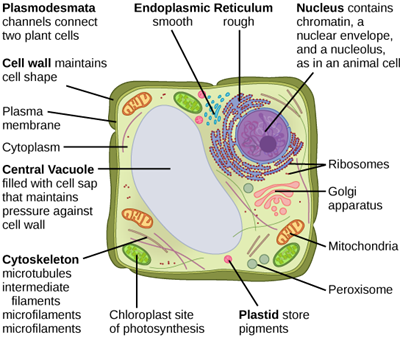
PUMPA - SMART LEARNING
எங்கள் ஆசிரியர்களுடன் 1-ஆன்-1 ஆலோசனை நேரத்தைப் பெறுங்கள். டாப்பர் ஆவதற்கு நாங்கள் பயிற்சி அளிப்போம்
Book Free DemoCell organelles and their functions:
Cell wall:
It is found only in plant and bacterial cells, and it is a hard structure that surrounds and protects the cell, makes it rigid and strong. It serves as the supporter and protector of the cell.
Cell membrane:
It is found in both prokaryotic and eukaryotic cells. It holds and protects the cell and controls the materials' movement in and out of the cell as it separates the cell from the surroundings. It is also known as the Gate of the cell. The cell membrane is selectively permeable.
Cytoplasm:
It is a watery, gel-like material in which all the cell organelles are found. It is the area of the cell where we can observe movement.
Mitochondria:
These are cell organelles that produce and supply most of the energy for the cell. Hence they are known as the powerhouses of the cell.
Chloroplasts:
These are cell organelles that are found only in certain autotrophic algae and plant cells. They contain a green colour pigment known as chlorophyll. This pigment helps capture the solar energy and uses it in the production of food for the cell by the process of photosynthesis. Hence these are known as food producers.
Vacuoles:
These are structures that store food, water and chemicals and are commonly called storage tanks. They are found in large sizes in the plant cells.
It is found only in plant and bacterial cells, and it is a hard structure that surrounds and protects the cell, makes it rigid and strong. It serves as the supporter and protector of the cell.
Cell membrane:
It is found in both prokaryotic and eukaryotic cells. It holds and protects the cell and controls the materials' movement in and out of the cell as it separates the cell from the surroundings. It is also known as the Gate of the cell. The cell membrane is selectively permeable.
Cytoplasm:
It is a watery, gel-like material in which all the cell organelles are found. It is the area of the cell where we can observe movement.
Mitochondria:
These are cell organelles that produce and supply most of the energy for the cell. Hence they are known as the powerhouses of the cell.
Chloroplasts:
These are cell organelles that are found only in certain autotrophic algae and plant cells. They contain a green colour pigment known as chlorophyll. This pigment helps capture the solar energy and uses it in the production of food for the cell by the process of photosynthesis. Hence these are known as food producers.
Vacuoles:
These are structures that store food, water and chemicals and are commonly called storage tanks. They are found in large sizes in the plant cells.
Nucleus:
It is the brain of the cell as it regulates and controls all the activities of the cell. Hence it is also known as the control centre.
It is the brain of the cell as it regulates and controls all the activities of the cell. Hence it is also known as the control centre.
Nuclear membrane:
It is the structure that surrounds and protects the nucleus. It also controls the movement of materials in and out of the nucleus. The nuclear membrane is also known as the gate of the nucleus.
Centrioles:
These are cylindrical organelles that serve as the skeletal system of the cell. They are found only in animal cells.
Plant cell and animals cell:
Plants and animals are living organisms. Hence, they are made up of cells. Both plant and animal cells are eukaryotic as they have a membrane-bound nucleus.
Plant cell:
The plant cells are usually larger and are complex. This complexity is due to the presence of a cell wall in addition to its cell membrane.
Plant cell:
The plant cells are usually larger and are complex. This complexity is due to the presence of a cell wall in addition to its cell membrane.
The plant's cells have specialized organelles known as chloroplast, which contain chlorophyll. Chlorophyll is a green coloured pigment that is involved in the process of photosynthesis. In addition to this, they have large vacuoles that help in the storage of food and water. These cells lack centrioles.

Plant cell
Animal cells:
These cells are generally smaller than the plant cells and are not as hard as plant cells. They lack a cell wall and chloroplast. When compared to the plant cells, they have many small vacuoles. They also contain centrioles.

Animal cell
Differences between plant cells and animal cells:
Part | Plant cells | Animal cells |
| Cell membrane | Present | Present |
| Cell wall | Present | Absent |
| Nucleus | Present | Present |
| Nuclear membrane | Present | Present |
| Cytoplasm | Present | Present |
| Vacuole | Present or big | Absent or small |
| Plastids | Present | Absent |
Reference:
https://upload.wikimedia.org/wikipedia/commons/3/3f/Figure_04_03_01b.png
https://upload.wikimedia.org/wikipedia/commons/thumb/0/0d/0312_Animal_Cell_and_Components.jpg/512px-0312_Animal_Cell_and_Components.jpg